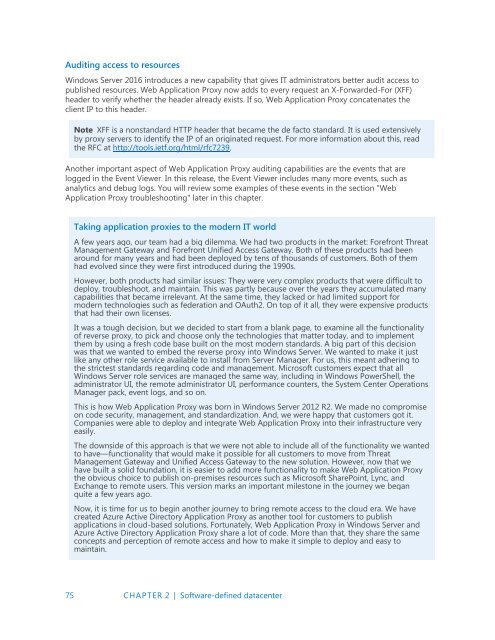Introducing
IntroducingWindowsServer2016_ebook
IntroducingWindowsServer2016_ebook
Create successful ePaper yourself
Turn your PDF publications into a flip-book with our unique Google optimized e-Paper software.
Auditing access to resources<br />
Windows Server 2016 introduces a new capability that gives IT administrators better audit access to<br />
published resources. Web Application Proxy now adds to every request an X-Forwarded-For (XFF)<br />
header to verify whether the header already exists. If so, Web Application Proxy concatenates the<br />
client IP to this header.<br />
Note XFF is a nonstandard HTTP header that became the de facto standard. It is used extensively<br />
by proxy servers to identify the IP of an originated request. For more information about this, read<br />
the RFC at http://tools.ietf.org/html/rfc7239.<br />
Another important aspect of Web Application Proxy auditing capabilities are the events that are<br />
logged in the Event Viewer. In this release, the Event Viewer includes many more events, such as<br />
analytics and debug logs. You will review some examples of these events in the section "Web<br />
Application Proxy troubleshooting" later in this chapter.<br />
Taking application proxies to the modern IT world<br />
A few years ago, our team had a big dilemma. We had two products in the market: Forefront Threat<br />
Management Gateway and Forefront Unified Access Gateway. Both of these products had been<br />
around for many years and had been deployed by tens of thousands of customers. Both of them<br />
had evolved since they were first introduced during the 1990s.<br />
However, both products had similar issues: They were very complex products that were difficult to<br />
deploy, troubleshoot, and maintain. This was partly because over the years they accumulated many<br />
capabilities that became irrelevant. At the same time, they lacked or had limited support for<br />
modern technologies such as federation and OAuth2. On top of it all, they were expensive products<br />
that had their own licenses.<br />
It was a tough decision, but we decided to start from a blank page, to examine all the functionality<br />
of reverse proxy, to pick and choose only the technologies that matter today, and to implement<br />
them by using a fresh code base built on the most modern standards. A big part of this decision<br />
was that we wanted to embed the reverse proxy into Windows Server. We wanted to make it just<br />
like any other role service available to install from Server Manager. For us, this meant adhering to<br />
the strictest standards regarding code and management. Microsoft customers expect that all<br />
Windows Server role services are managed the same way, including in Windows PowerShell, the<br />
administrator UI, the remote administrator UI, performance counters, the System Center Operations<br />
Manager pack, event logs, and so on.<br />
This is how Web Application Proxy was born in Windows Server 2012 R2. We made no compromise<br />
on code security, management, and standardization. And, we were happy that customers got it.<br />
Companies were able to deploy and integrate Web Application Proxy into their infrastructure very<br />
easily.<br />
The downside of this approach is that we were not able to include all of the functionality we wanted<br />
to have—functionality that would make it possible for all customers to move from Threat<br />
Management Gateway and Unified Access Gateway to the new solution. However, now that we<br />
have built a solid foundation, it is easier to add more functionality to make Web Application Proxy<br />
the obvious choice to publish on-premises resources such as Microsoft SharePoint, Lync, and<br />
Exchange to remote users. This version marks an important milestone in the journey we began<br />
quite a few years ago.<br />
Now, it is time for us to begin another journey to bring remote access to the cloud era. We have<br />
created Azure Active Directory Application Proxy as another tool for customers to publish<br />
applications in cloud-based solutions. Fortunately, Web Application Proxy in Windows Server and<br />
Azure Active Directory Application Proxy share a lot of code. More than that, they share the same<br />
concepts and perception of remote access and how to make it simple to deploy and easy to<br />
maintain.<br />
75 CHAPTER 2 | Software-defined datacenter


